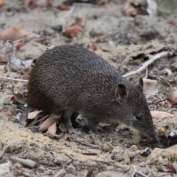Website to preserve backyard wildlife in Australia

A new digital information and advice hub will tackle the unintentionally harmful human behaviour that puts Australia's incredible native wildlife at risk.
The Healthy Wildlife Healthy Lives website features advice on how to keep wildlife healthy and information on the types of diseases that can be transmitted from people and pets to native species.
"Healthy wildlife means healthier environments for all of us, so it is important we interact with our native species in the correct way to protect their health and wellbeing, as well as our own," said Murdoch University's Associate Professor Alan Lymbery, who is working on the project with his colleague Emeritus Professor Andy Thompson.
"As human populations increase and more of our living spaces overlap with bushland, we will see more wildlife in our backyards. This is wonderful for us but we must be careful not to pass on disease and parasites that might be easy for us to shake off, but deadly for native animals and birds."
Professor Lymbery and Professor Thompson helped to develop the new Healthy Wildlife Healthy Lives website, which also features user-friendly practical tips, easy-to-understand information about species and the diseases that affect them and a guide to upcoming workshops for the public.
The academics came up with the idea for the project while volunteering at wildlife rehabilitation centres.
"We could see first-hand the impact that people have on wildlife, by unintentionally exposing them to increased risk from parasitic diseases," said Professor Thompson.
"For example, a study of quendas living in the hills by our colleague Alison Hillman found they host a number of parasites. Most were native, having no harmful effect on the quenda, but several parasites probably came from people's pets. Stickfast fleas, for example, are likely to have been transmitted to quenda from backyard poultry.
"Alison's study also found a link between quenda obesity and being fed by humans. Those found in urban setting were bigger than their bushland counterparts. Alison found this impacted their reproductive activity."
Professor Lymbery added: "We know that educating the public on how parasitic diseases may be spread from people and pets to wildlife can play a major role in helping our precious native species.
"Healthy Wildlife Healthy Lives is very much a One Health project," he said. "This is a global initiative that recognises that the health of people, animals and the environment are all directly linked.
"Although we usually concentrate on the diseases that people or our domestic animals can contract from wildlife, in fact there are many parasitic diseases that are transmitted in the opposite direction; from us or our pets to wildlife."
The website is a major part of the overall Healthy Wildlife Healthy Lives project, which has been developed by the Eastern Metropolitan Regional Council (EMRC), in partnership with the Murdoch Professors, Kanyana Wildlife Rehabilitation Centre and Native Animal Rescue. Support for the project has come from Lotterywest.
This project is currently being piloted in Perth's eastern region, with the aim of rolling it out across the Perth metropolitan region in the future.
The next steps in the project will see 400 information packs sent out to veterinarians, community groups, local government and wildlife rehabilitation centres. Upcoming workshops are advertised on the Healthy Wildlife event page here.
Provided by Murdoch University




















